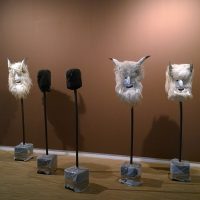Ioana Nemes: The White Team (Satan), 2009, fur, leather, horns, gold, epoxide, paint, lacquer, wood, Courtesy Ovidiu Sandor Collection
The artworks presented were selected from four important Romanian private collections of today – the collections of Mircea Pinte, Ovidiu Sandor, Răzvan Bănescu and the Plan B Foundation – found in three different cities: Cluj, Timisoara and Bucharest. The selection, compiled with the help of curator Diana Marincu, provides a comprehensive and informative cross-section of contemporary Romanian art, though it also includes examples of Romanian neo-avantgarde works, which suggest that, although every generation has its own perceptions and responses, the creators and consumers of art can forge bridges between generations. Indeed, it has been said of the so-called Cluj School that its representatives harbour a keen interest in the recent past.
The collections boast emblematic works by renowned Romanian artists such as Mircea Cantor, Adrian Ghenie, Ciprian MureSan, Vlad Nancă, Ioana Nemes, Serban Savu and Mircea Suciu, who rose to international fame as their patrons’ collections were coming into being. At the same time, the collectors’ interest in the young generation of artists, for instance Mi Kafchin, Alex Mirutziu and George Crîngasu, extends the focus to a variety of mediums and subjects.
While there are many overlaps among these collections, each assembly of artworks has its own distinctive character and geographical focus, and each reflects a unique type of interest. This exhibition strives to offer insights into the personal tastes of these passionate collectors, for whom art collection, as Răzvan Bănescu so aptly remarked in an interview, is not merely a hobby, but a life model.
Their patronage has been instrumental in the integration of contemporary Romanian art into public spaces and the international art scene. The exhibition can be a platform to initiate meaningful comparisons between private art collecting in Hungary and Romania: the 2014 exhibition Contemporaries: Collectors and Artists, which presented works from 38 Hungarian collections, was also organized by the Budapest Gallery.
